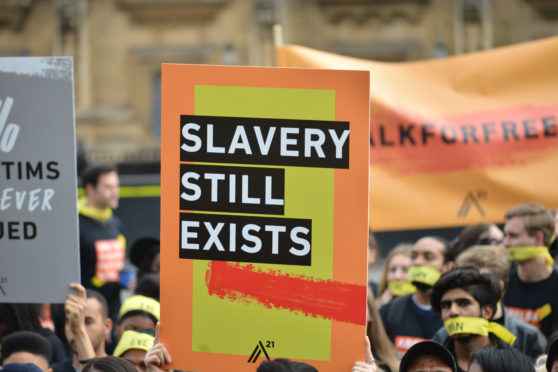I am a person very careful with money and I love a bargain. I am delighted if I can find something that is cheaper than expected.
I shop around, and can tell the value of things. It is a good day for me when I come across an item that I have wanted for some time at a greatly reduced cost. I know that I am not alone, there are many other bargain hunters like me out there. However, there is another side to the ready availability of cheaper goods or services. There are times when we should ask the question: ‘why is this so cheap’?
Recently I was in conversation with a senior officer from Police Scotland. We were speaking about modern slavery in the UK. The officer told me that slavery was on the increase, and that the reality is that there are many more slave workers here than the official figures suggest. I asked why this was. The officer replied: ‘Well British people like cheap things’. Then the officer continued to tell me how those who are slaves are very close to us, often hidden in plain sight.
We are aware that slavery is a significant part of our nation’s past. The story of the abolition of slavery, including the roles played by the churches, is something that we can rightly be proud of. And yet this insidious practice of enslaving and owning human beings is again on the rise.
In the last couple of weeks our attention has been on the dreadful tragedy of the deaths in the container lorry in Essex. As the investigation has continued, we have all had the opportunity to learn more about the modern slave routes across Europe, and to appreciate more fully how slavery is a global business which preys on people who are poor and vulnerable. We can see how young people are easy to exploit and so why so many of the slaves identified in the UK are under 35. They are brought into this country and then disappear into the black economy.
Most of the slaves in the UK have been trafficked from overseas, but there are a significant number of UK nationals who are slaves. Forced slave labour is found in industries like agriculture, manufacturing, and construction. Slavery is common in the hospitality industry. Slaves can be workers in nail bars and car washes, while some are forced to beg on the streets. And, sadly, many women and girls are trafficked for the sex industry. Wherever they work, the results are either increased profits for those exploiting the slaves, or cheaper goods, or both. The majority of slaves are young and many are children.
The deaths in Essex have alerted us afresh to this issue, and many of us will be wondering how it is that one person can look on another and see a commodity, someone who is not a person but something to be bought or sold. There are all kinds of motivations for this, but alongside the desire for financial gain there is the ability to dismiss people who are different in some way. Slaves are seen by those who trade them as not worth the same respect and care as everyone else. When people are seen as significantly different, in some way then it is easy to think of them differently. They are people to be used, not people to be respected and given full human rights, the rights that we should expect for every person.
If we find slavery abhorrent then there are things that we can do to resist this steadily-increasing abusive practice. For example, we can pay attention to those who work around us. If we pay close attention we might encounter those for whom something just does not look right. If the context is such that we are receiving a very cheap service of some kind, or are being offered something to buy which is extraordinarily cheap, then we might wonder if there has been slavery or exploitation involved somewhere along the supply chain.
When we can see such bargains before us then we have to make a choice. If we purchase the item or service, then we are buying into a system of abuse, and so participating in it to some degree.
Two hundred years ago, people in Scotland understood why the purchase of sugar and tobacco were political and social issues. They understood that in the production of these much-loved commodities human beings were exploited. They raised their voices, and changed shopping habits. They lobbied parliament and pushed for changes in the law so that all people, whatever their place in the supply chain, could be protected. It is time for us to have such an awareness with regard to modern slavery.
The Rt Rev Anne Dyer is Episcopalian Bishop of Aberdeen and Orkney and Scotland’s first female bishop

